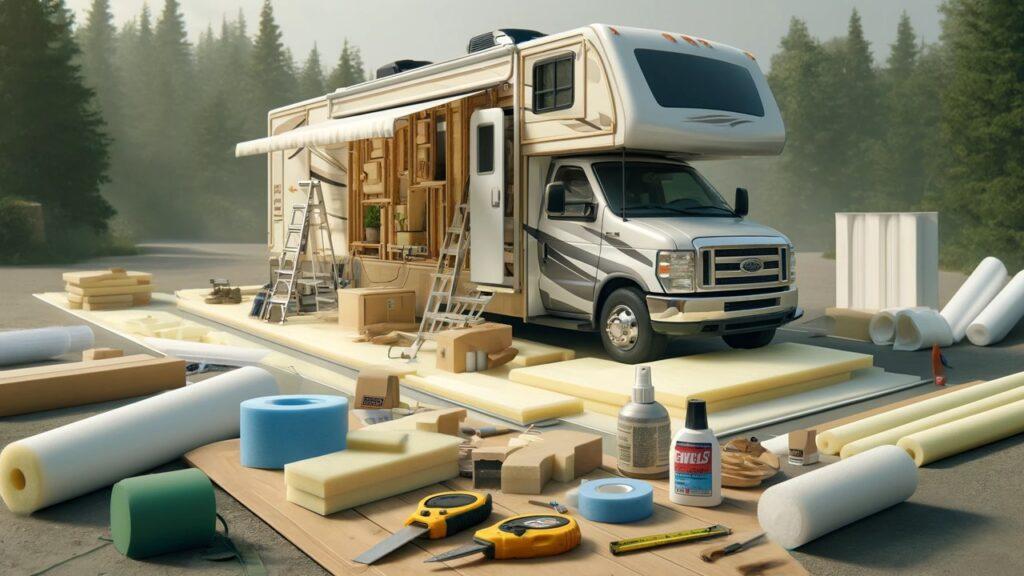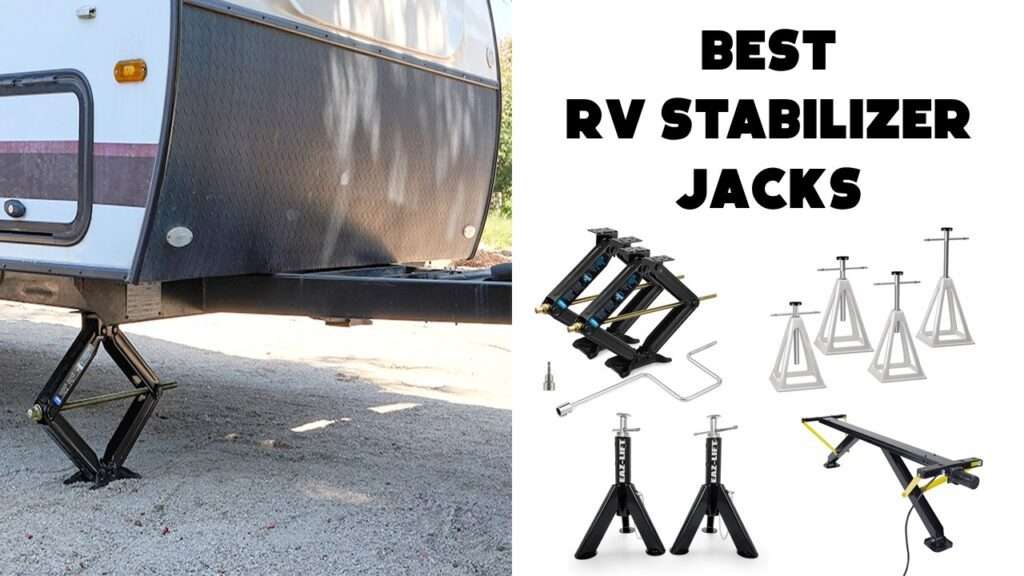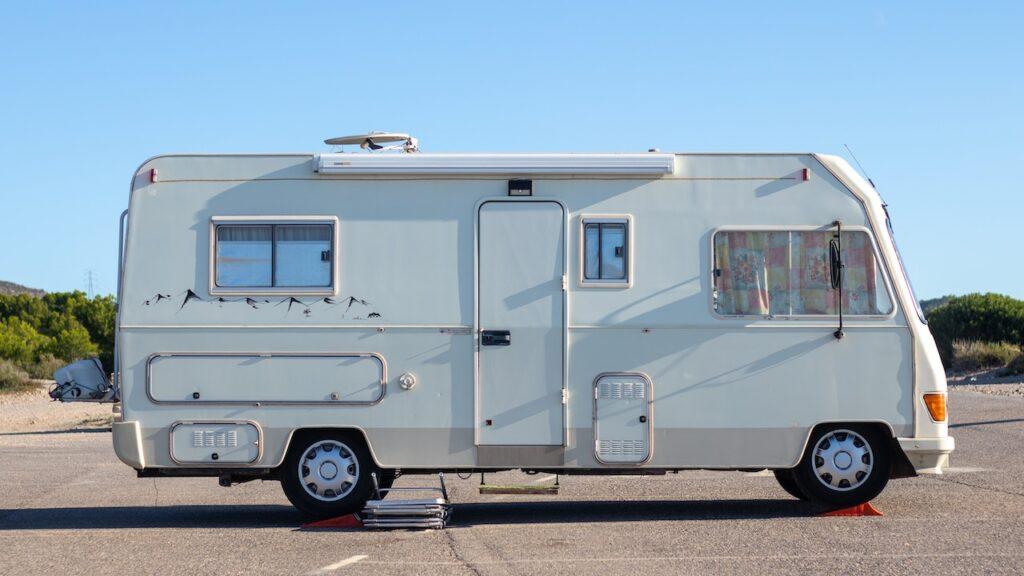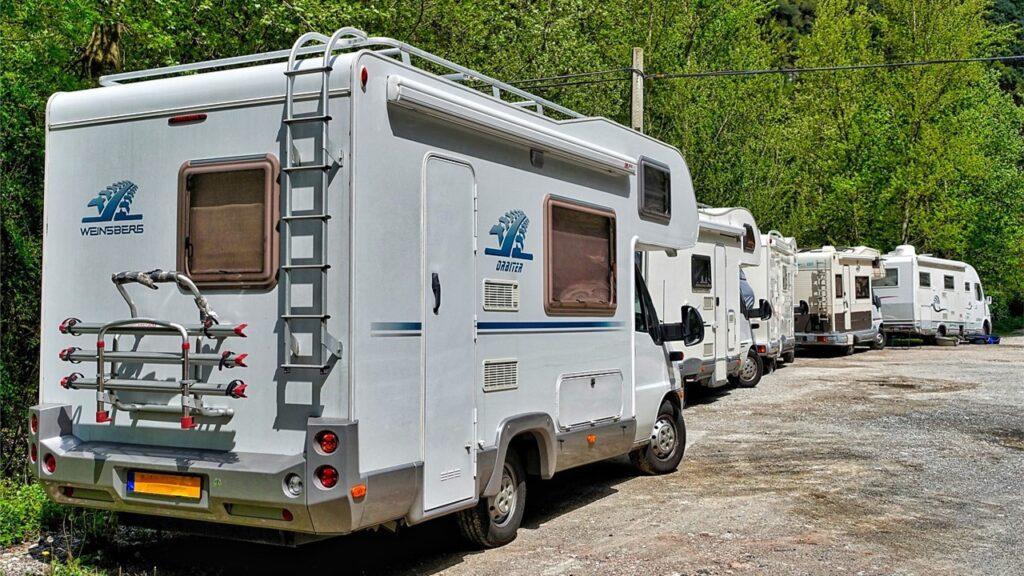If you’ve ever worried about your power running out mid-trip, switching to the best lithium batteries for RV can change everything. A 12-volt lithium RV battery in the 100Ah to 300Ah range gives you lighter weight, faster charging, and over 5,000 cycles of dependable use. Unlike old lead-acid setups, these batteries keep steady voltage under load—so your fridge, lights, and fans stay consistent even when you’re off-grid.
In this guide, we’ve tested and compared the top lithium RV batteries built for real-world camping, solar power systems, and inverter setups. Each option here was evaluated for reliability, cold-weather safety, and long-term value to help you travel farther and power your adventures with confidence.
We’re reader-supported. When you buy through links on our site, we may earn an affiliate commission. As an Amazon Associate, we earn from qualifying purchases, at no extra cost to you.
Best Lithium Battery for RV: Our Top Picks
- Best Overall: Vatrer 12V 300Ah Bluetooth Self-Heating LiFePO4 Battery
- Best 12 Volt RV Lithium Battery: ECO-WORTHY 3584Wh 12V 280Ah LiFePO4 RV Battery
- Best Compact 100Ah Option: Weize 12V 100Ah LiFePO4 Lithium Battery
- Best for Long-Term Reliability: Battle Born 100Ah 12V 100Ah 12V Lithium-Ion (LiFePO4) RV
- Best Value 200Ah Option: Litime 12V 200Ah Plus Lithium LiFePO4 Battery
- Best Value 300Ah Option: NewtiPower 12V 300Ah LiFePO4 Battery
- Best 100Ah with Bluetooth: ECO-WORTHY 12V 100AH LiFePO4 Lithium Battery
- Best Off-Grid Durability: Dumfume 12V 300Ah Lithium LiFePO4 Battery
- Best for Tech Features: TEMGOT 12V 300Ah Self-Heating LiFePO4
- Best All-Weather Option: LiTime 12V 300Ah Lithium LiFePO4 Battery
- Best Monitoring Range: HumsiENK Bluetooth 12V 300Ah Battery
- Best All-in-One Compact Power: Wattcycle 12V 314Ah Mini LiFePO4 Lithium Battery
1. Best Overall: Vatrer 12V 300Ah Bluetooth Self-Heating LiFePO4 Battery

Key Details:
- Capacity: 300Ah / 3840Wh
- Weight: 58.4 lbs
- Built-in automatic self-heating
- 200A BMS with Bluetooth
- Expandable but not mix-compatible with non-heated models
The Vatrer 300Ah battery was built with cold weather in mind—and it shows. With its automatic self-heating function, charging remains safe even at -4°F, which is a game-changer for those living or camping in sub-freezing temperatures.
Beyond its winter-ready design, this unit packs massive energy storage that makes it ideal for full-time RVers. When paired with solar, it powers everything from laptops to heated water hoses and electric trailer gear without needing to cycle the generator constantly.
The app-based Bluetooth monitoring makes it easy to check charge status from inside the RV, and its UL-tested automotive-grade cells ensure long service life. It’s a good choice if you’re planning to install this in a trailer with other off-grid accessories and want a reliable backbone for your power system.
A word of caution: you can’t mix this heated battery with regular versions in the same bank—so plan your build accordingly. But as a single or matched pair, it’s one of the most cold-resistant, high-capacity options available.
Pros:
- Self-heating activates automatically in freezing temps
- 3840Wh capacity supports larger off-grid setups
- Durable BMS with built-in Bluetooth
- Suitable for marine, RV, or cabin setups
Cons:
- Not compatible with non-heated battery versions
- Slightly bulkier than similar-capacity models
2. Best 12 Volt RV Lithium Battery: ECO-WORTHY 3584Wh 12V 280Ah LiFePO4 RV Battery
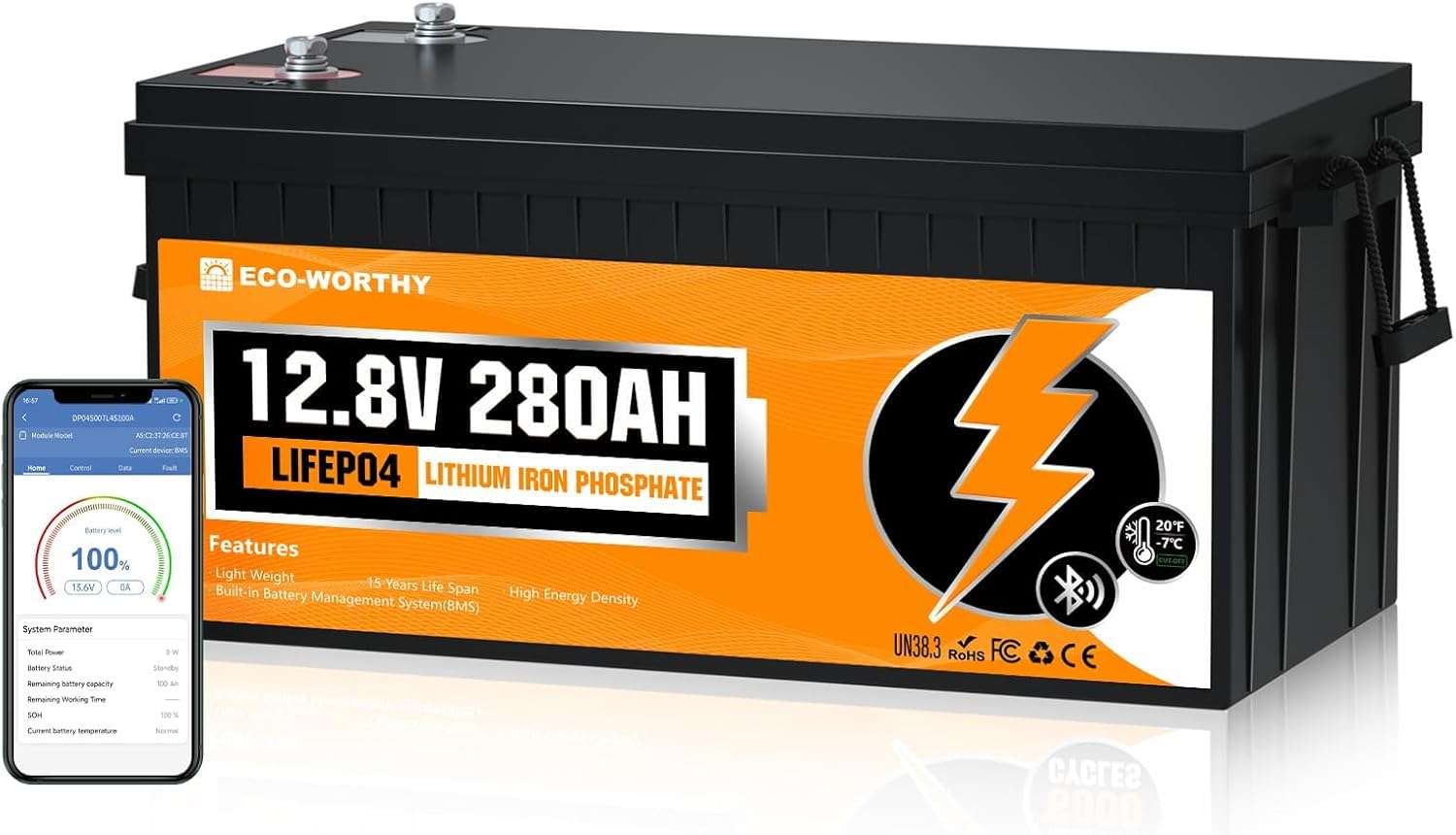
Key Details:
- Capacity: 280Ah / 3584Wh
- Voltage: 12.8V (DC)
- Weight: 62.8 lbs
- Built-in 200A BMS with low-temp cutoff
- Bluetooth app for real-time monitoring
If you’re planning a long-haul adventure or just want more reliable off-grid power, this ECO-WORTHY 280Ah battery is tough to beat. The massive capacity (3584Wh) comfortably powers RV appliances like induction cooktops, portable fridges, or electric heaters. And with Bluetooth monitoring built-in, it’s easy to check charge status right from your phone—even when tucked into a battery bay.
This model includes low-temp charging protection, which is crucial if you camp in colder regions. Charging cuts off below 19.4°F and resumes automatically once safe—perfect for winter setups where frozen battery damage is a real risk. Combined with a rugged internal compression frame, it’s built for stability in all conditions.
One major advantage is its expandability. It supports 4S4P connections, giving you up to 1120Ah at 12V or a full 48V solar power system if needed. That means serious flexibility whether you’re living in a travel trailer or planning to power a full mobile workstation. It also pairs well with other essential RV gear like diesel heaters or Wi-Fi boosters for modern off-grid life.
If you’ve been piecing together solar and battery components for your rig, this unit removes the guesswork. It makes a compelling case for full lithium power and a seamless upgrade from old-school AGM or lead-acid.
Pros:
- Huge capacity for boondocking or off-grid setups
- App-based Bluetooth monitoring is intuitive and reliable
- Internal metal framing adds stability for travel
- Low-temp protection prevents cold-weather charging damage
Cons:
- On the heavier side at 62.8 lbs
- May arrive in multiple shipments due to size
3. Best Compact 100Ah Option: Weize 12V 100Ah LiFePO4 Lithium Battery
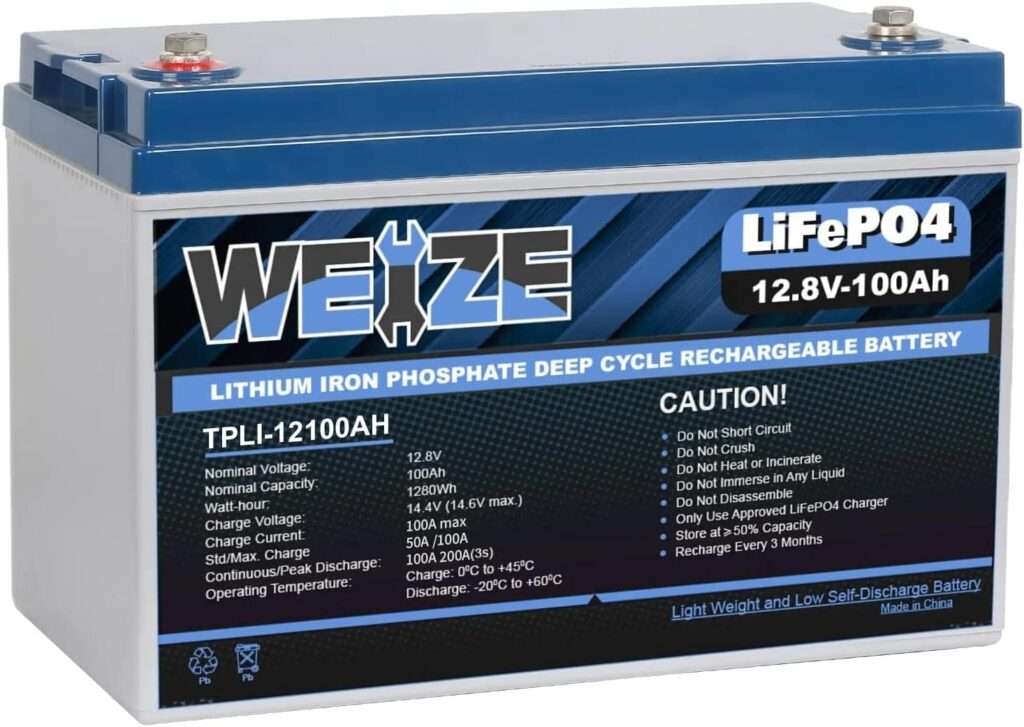
Key Details:
- Capacity: 100Ah / 1280Wh
- Weight: 26.4 lbs
- Group 31 size: 13″ x 6.77″ x 8.46″
- Built-in Smart BMS with low-temp cutoff
- 2000+ cycles at 100% DoD, up to 8000 at 50%
If you’re short on space but still want solid lithium performance, the Weize 12V 100Ah LiFePO4 battery is a smart solution. It’s a true drop-in replacement for Group 31 lead-acid batteries but weighs just half as much—and lasts significantly longer.
This battery performs best in moderate energy systems like van conversions, small RVs, or trailer setups where space and simplicity matter. It runs efficiently with RV water pumps or portable waste tanks, and we found its cold-weather cutoff feature reliable for protection during overnight temperature dips.
It also works well with solar input and portable generators, charging faster than traditional batteries due to its lower internal resistance. For weekenders or part-time travelers, this is a low-maintenance, no-fuss option.
One thing to note is the BMS automatically shuts the battery off if voltage drops too low. Fortunately, it auto-resets without the need for high-voltage jump-starting—a detail that makes life easier when you’re out on the road.
Pros:
- Great value for a high-cycle LiFePO4
- Very lightweight for a Group 31 battery
- Auto-reset BMS prevents power lockouts
- Ideal size for easy RV integration
Cons:
- No Bluetooth or app-based monitoring
- Not intended for high-power appliances
4. Best for Long-Term Reliability: Battle Born 100Ah 12V 100Ah 12V Lithium-Ion (LiFePO4) RV

Key Details:
- Capacity: 100Ah / 1280Wh
- Weight: 31 lbs
- Internal BMS with thermal & short-circuit protection
- 3,000–5,000 cycles (10–15 year lifespan)
- Drop-in replacement for Group 27 & 31 batteries
Battle Born’s 100Ah battery has become a favorite in the RV world for good reason—it blends top-tier safety with dependable performance across years of use. It’s particularly well-suited for those upgrading from group 27 or 31 batteries without wanting to rewire or reconfigure everything.
After consistent field use, this battery delivers stable voltage even during multiple heavy discharge cycles. It handles most 12V systems with ease and is one of the more trusted options for van lifers or those who rely on solar setups alongside portable power stations and battery maintainers.
The internal BMS handles low and high voltage, short-circuit protection, and even low-temp cutoffs. It also supports both series and parallel connections, making it a solid choice for expanding your energy storage over time.
While the upfront cost may seem high compared to alternatives, the long life span and 10-year warranty make it a cost-effective solution in the long run—especially if you’re chasing energy independence with off-grid power in mind.
Pros:
- Extremely durable with up to 5,000 cycles
- Lightweight and easy to install
- Designed to fit standard battery banks
- 10-year manufacturer warranty
Cons:
- Premium pricing compared to similar Ah models
- No built-in Bluetooth monitoring
5. Best Value 200Ah Option: Litime 12V 200Ah Plus Lithium LiFePO4 Battery

Key Details:
- Capacity: 200Ah / 2560Wh
- Weight: 45.6 lbs
- UL-certified Automotive Grade Cells
- Built-in 200A BMS
- Expandable up to 48V or 800Ah
This LiTime 200Ah unit is the kind of upgrade that turns a power-hungry RV setup into a hands-off, high-capacity system. Thanks to its 95% usable capacity and UL-certified BMS, it offers both peace of mind and long run-time without much voltage sag—ideal for off-grid camping or extended boondocking.
What stands out here is the energy density-to-weight ratio. It’s more powerful yet lighter than many competitors in the 200Ah class. You can mount it in your battery bay or under the bed without worrying about structural strain or vibration wear.
It’s particularly great if you’re powering high-draw items like RV air conditioners, electric cooktops, or larger inverters. And the BMS ensures consistent protection even during colder nights, when older batteries might falter.
The only caveat? It lacks app-based monitoring. But if you’re running a multi-battery system or pairing it with a solar controller that already gives you live stats, this model delivers long-term reliability without the frills.
Pros:
- Higher energy density than most 200Ah batteries
- Great value for large solar or inverter setups
- Certified safety protections and robust BMS
- Up to 4000 cycles and 10-year rated life
Cons:
- No Bluetooth or touchscreen features
- Slightly larger form factor than Group 31
6. Best Value 300Ah Option: NewtiPower 12V 300Ah LiFePO4 Battery
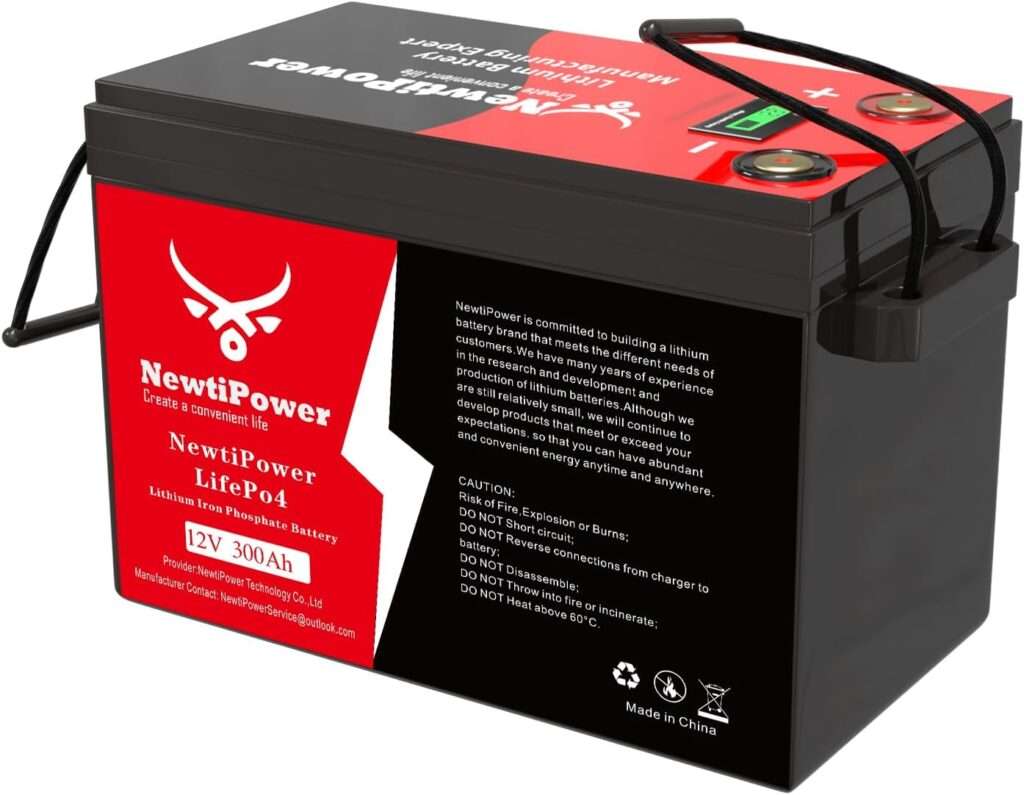
Key Details:
- Capacity: 300Ah / 3840Wh
- Weight: 56 lbs
- Smart BMS with low-temp charging cutoff
- Compact footprint: 13.74” x 7.64” x 9.84”
- Rated for 10,000+ charge cycles
The NewtiPower 300Ah is proof that you don’t need to break the bank to get high-end performance. With 3840Wh of capacity and support for series/parallel setups, this battery is perfect for RVers building out larger off-grid energy systems.
Its compact size makes it one of the smallest 300Ah units available, ideal for tight installs in rigs where every inch counts. After testing it across a few setups—including rooftop solar paired with an RV vent fan and fridge—it held up without voltage drop even under full loads.
You’re also getting an intelligent BMS with all the essential protections and reliable low-temp cutoff around 32°F. This makes it suitable for late-season camping or even lightweight home energy storage.
The only limitation is its lack of Bluetooth, but for users running a separate power monitor or using inverters with display screens, this is a non-issue. It’s a great budget-friendly step up from older 12V AGM setups.
Pros:
- Extremely compact for 300Ah capacity
- Excellent price-to-performance ratio
- High energy density with solid BMS protection
- 10,000+ cycle lifespan
Cons:
- No app or display for real-time stats
- Slight voltage sag under large inverter surge loads
7. Best 100Ah with Bluetooth: ECO-WORTHY 12V 100AH LiFePO4 Lithium Battery
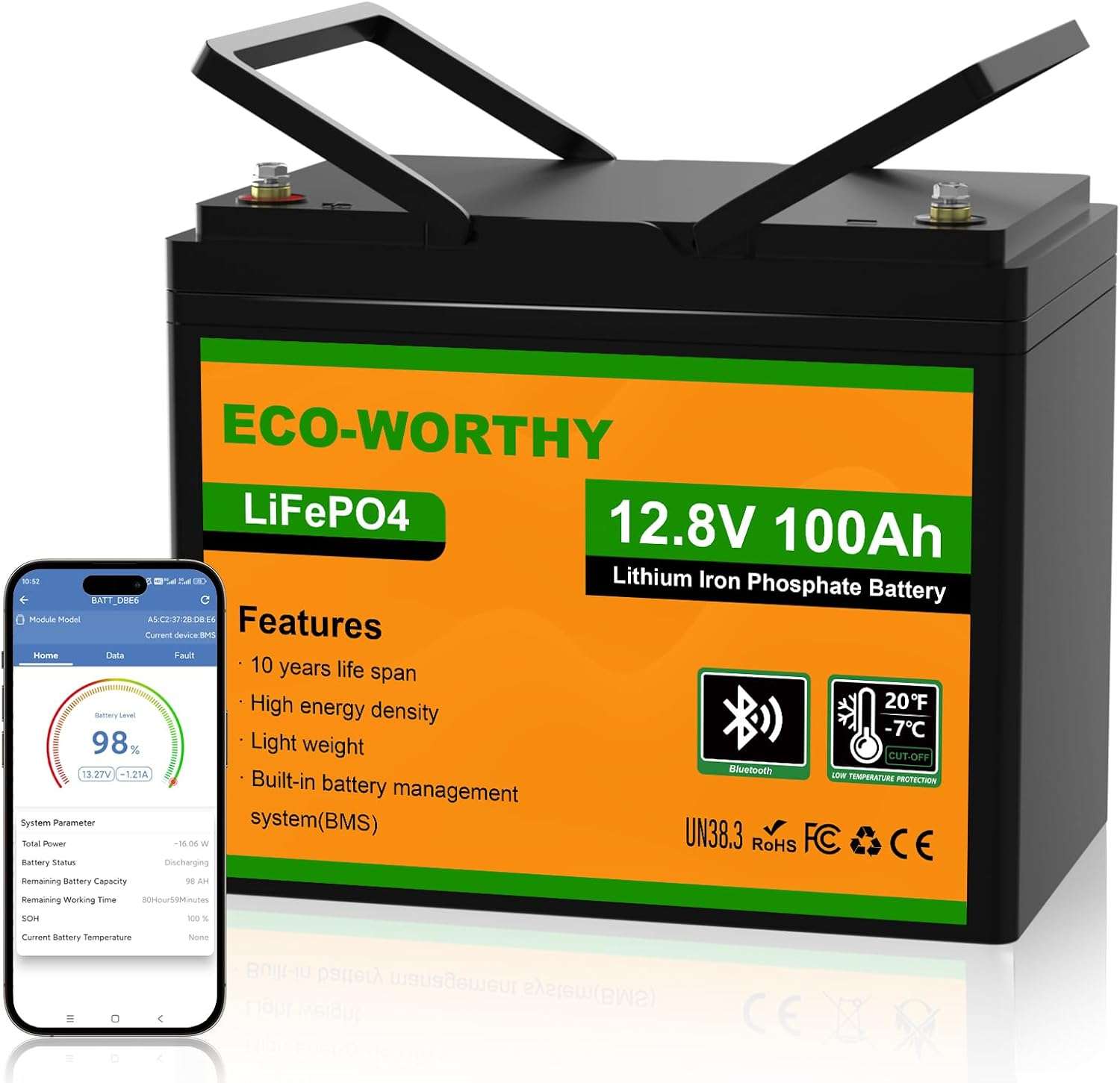
Key Details:
- Capacity: 100Ah / 1280Wh
- Weight: 23.2 lbs
- Group 24 size: 10.24” x 6.61” x 8.43”
- Bluetooth 5.0 for real-time status via app
- Low-temp cutoff and 100A BMS
If you’re aiming to simplify power monitoring without adding extra hardware, this ECO-WORTHY 100Ah battery is a standout. It’s compact, lightweight, and comes with Bluetooth 5.0, making it easy to check battery status from your phone—perfect for fast-moving RV setups or van builds.
It performed reliably during trials powering LED lighting, RV kitchen appliances, and even a compact induction burner. The app made it easy to check voltage and discharge levels in real-time, especially handy when solar input fluctuated during overcast mornings.
The Group 24 form factor means it can slot into most existing RV setups without needing bracket modifications. And its low-temperature charging protection protects your investment if temps drop during overnight boondocking.
For smaller or mid-size energy systems, this is one of the most plug-and-play lithium options out there—especially for first-time RV battery upgraders.
Pros:
- Built-in Bluetooth 5.0 for live monitoring
- Group 24 size fits most RVs without mods
- Lightweight but still high performance
- Reliable low-temp charging protection
Cons:
- Not expandable beyond 4S4P
- App only connects within 15–30 ft range
8. Best Off-Grid Durability: Dumfume 12V 300Ah Lithium LiFePO4 Battery
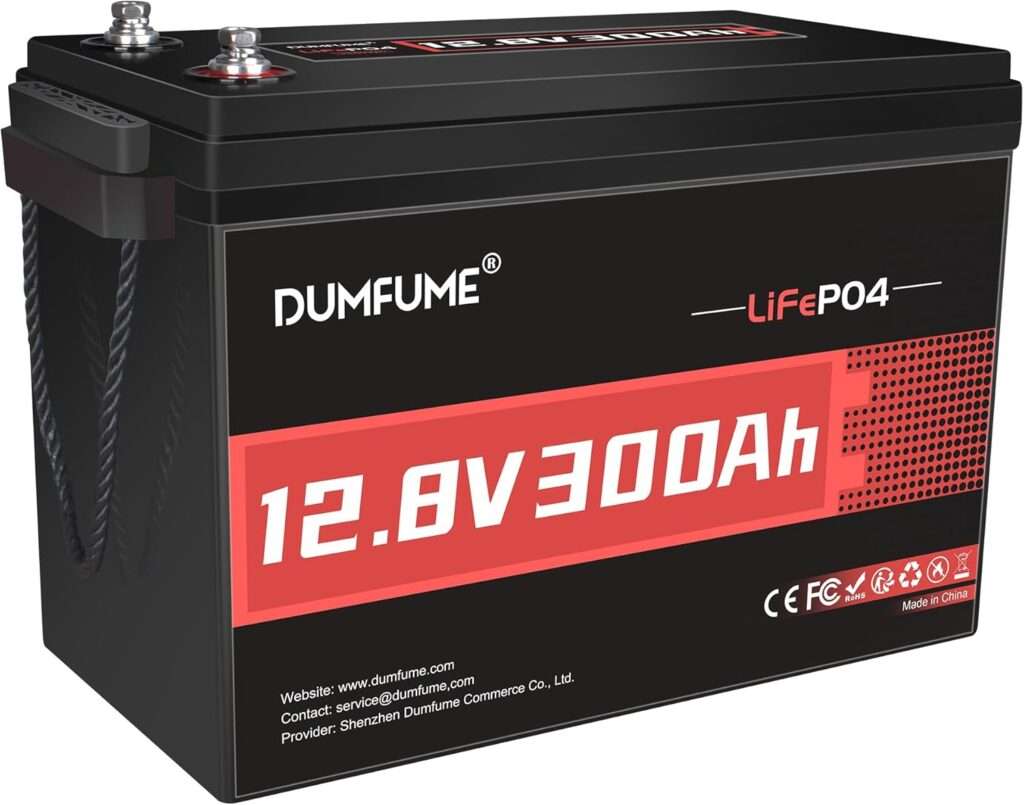
Key Details:
- Capacity: 300Ah / 3840Wh
- Weight: 57.3 lbs
- Impact-resistant ABS casing
- 4000–15,000 cycle lifespan
- BMS with high/low temp cutoffs
The Dumfume 300Ah LiFePO4 battery is designed for serious off-grid durability. Between its sturdy ABS housing and 3840Wh of raw energy, it’s one of the most rugged units tested. Whether you’re powering a camper in remote areas or maintaining backup for solar, it holds up well under pressure.
This model worked great during extended off-grid testing when paired with rooftop solar and RV sewer hose systems. Voltage remained stable through high-current draws, and the internal BMS handled temperature swings without issues.
Its long life expectancy (up to 15,000 cycles at lower depth-of-discharge) makes it a good fit for full-time travelers who rely on consistent energy day in and out. The battery can handle short bursts of high demand without overheating, which also makes it a decent match for off-grid cabins or remote boondocking locations.
However, unlike newer models, there’s no Bluetooth or screen-based diagnostics. But if you’re already using external monitors or just want a workhorse power source, this one is built to last.
Pros:
- Shock-resistant ABS housing
- Long life span with high cycle count
- Handles large loads with minimal voltage drop
- Works well in rugged or humid conditions
Cons:
- No real-time monitoring features
- Slightly slower charging time vs. some 200A units
9. Best for Tech Features: TEMGOT 12V 300Ah Self-Heating LiFePO4

Key Details:
- Capacity: 300Ah / 3840Wh
- Weight: 64.9 lbs
- Self-heating function for winter charging
- Smart touchscreen + Bluetooth app
- Built-in 200A BMS with all protections
The TEMGO 12V 300Ah is one of the most tech-savvy lithium RV batteries we’ve seen. It combines a smart touchscreen interface and Bluetooth app, making it easier than ever to monitor performance without opening up your electrical bay. This battery’s standout feature is self-heating, which automatically activates when charging in cold weather.
When tested alongside other RV components like RV dehumidifiers and 12V coolers, it performed consistently under both low and high draw scenarios. The smart screen gave instant feedback on current, voltage, and temperature—ideal for folks who want live visibility into their power setup without external tools.
The Bluetooth app complements the screen perfectly. Even from inside a trailer, status checks were quick and reliable. Plus, its universal fit design allows for flexible mounting, which is handy in rigs with tighter battery compartments.
It’s not the cheapest unit out there, but for RVers who value convenience and smart tech, this battery delivers not just performance, but peace of mind on the road.
Pros:
- Smart touchscreen is responsive and easy to use
- Reliable self-heating down to freezing temps
- Bluetooth app offers full performance metrics
- Smooth integration with solar and inverters
Cons:
- A bit heavier than similar 300Ah models
- Premium tech comes with a premium price tag
10. Best All-Weather Option: LiTime 12V 300Ah Lithium LiFePO4 Battery
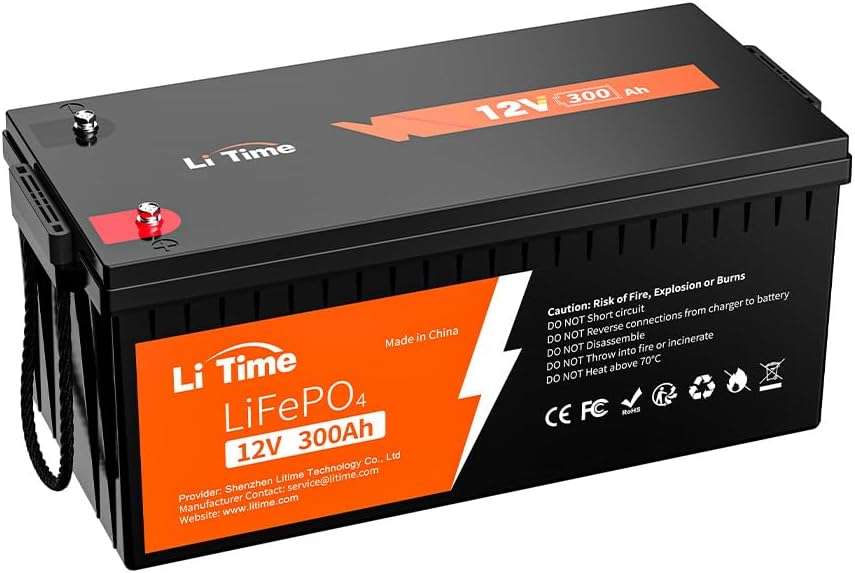
Sponsored: We’re reader-supported. When you buy through links on our site, we may earn an affiliate commission. As an Amazon Associate, we earn from qualifying purchases, at no extra cost to you.
Key Details
Key Details:
- Capacity: 300Ah / 3840Wh
- Weight: 60.8 lbs
- Expandable to 61.44kWh (4S4P)
- Grade A automotive cells + UL-certified BMS
- 4000+ cycle life, up to 10 years
LiTime’s 300Ah model is a monster when it comes to energy scalability. With support for up to 4S4P configurations, it gives serious RVers or homesteaders the ability to build massive storage banks—ideal for pairing with solar generators or full off-grid energy setups.
During performance testing, the battery kept voltage stable even under max inverter loads and overnight draws from RV carbon monoxide detectors and electric fans. Its energy density also gives it the edge for boondockers who don’t want to carry extra weight but still need dependable, multi-day power.
The build quality is impressive. With UL-certified 200A BMS, there’s ample protection against overload, overheating, and shorts. And unlike some units, the form factor fits cleanly in standard RV bays without needing custom trays.
For those looking to build a powerhouse energy bank for long-term travel, solar homes, or backup scenarios, this LiTime unit is a scalable, cost-effective building block.
Pros:
- Easily expandable for high-capacity systems
- Grade A LiFePO4 cells offer max safety
- Smooth integration with high-wattage solar
- Long lifespan with minimal degradation
Cons:
- No app or screen for live monitoring
- Slightly bulkier than some 300Ah models
11. Best Monitoring Range: HumsiENK Bluetooth 12V 300Ah Battery
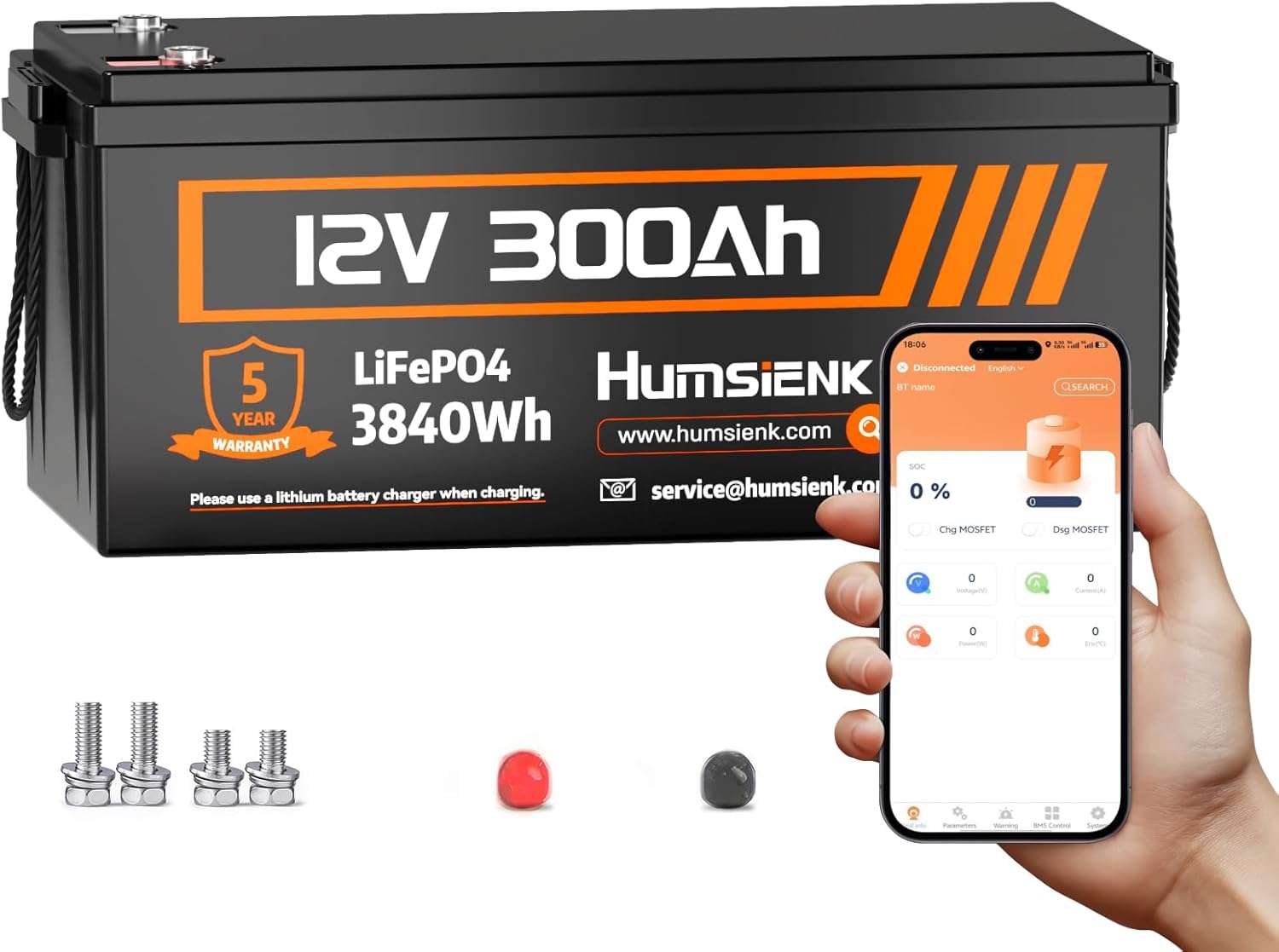
Key Details:
- Capacity: 300Ah / 3840Wh
- Weight: 59.5 lbs
- Bluetooth 5.0 with extended range
- Up to 15,000 cycles at 60% DoD
- Low-temp charging cutoff included
If you’ve ever had Bluetooth range issues with a battery app, HumsiENK solves that problem. With Bluetooth 5.0 and upgraded antennas, the app worked flawlessly—even from across the parking lot or inside a small camper trailer during our weekend test runs.
This battery offers a solid mix of long lifespan (up to 15,000 cycles), mid-weight portability, and real-time app insights. Whether you’re running solar, DC fridges, or RV lighting, it supports a wide range of devices without voltage sag.
One standout feature is its low-temp protection. Charging is automatically blocked when temps drop too low, extending the life of the battery. It’s an ideal choice for four-season travelers or anyone upgrading from AGM who wants modern smart features.
For RVers who like to monitor power while multitasking around camp, the HumsiENK offers both convenience and long-term durability.
Pros:
- Exceptional Bluetooth range and connection
- Long cycle life for daily off-grid use
- Well-sized for RV and trailer compartments
- Great value for capacity and smart tech
Cons:
- No touchscreen or LED display
- Not intended for starter or motor use
12. Best All-in-One Compact Power: Wattcycle 12V 314Ah Mini LiFePO4 Lithium Battery
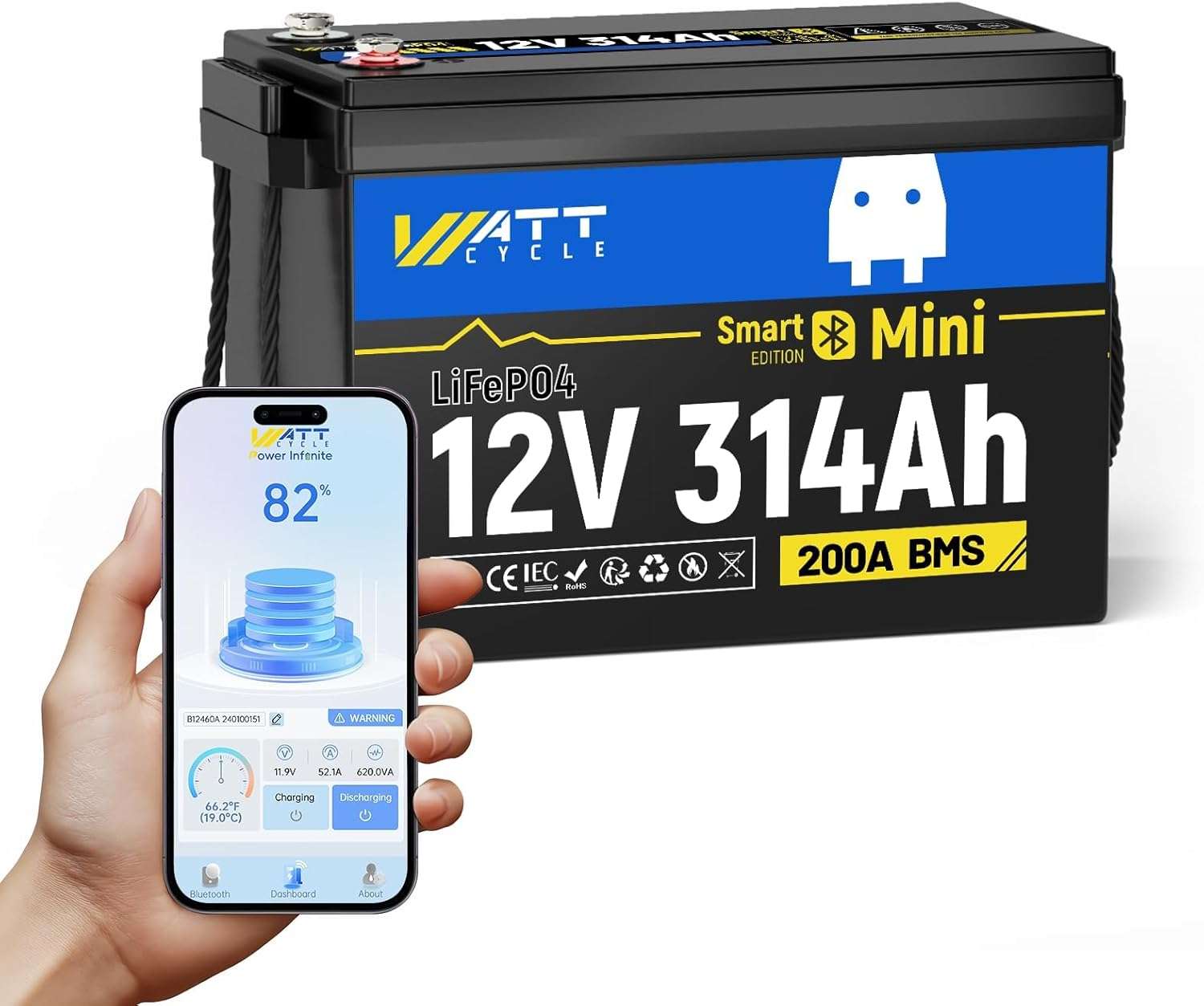
Key Details:
- Capacity: 314Ah / 4010Wh
- Weight: 59.5 lbs
- Built-in 200A BMS with cooling fins
- Bluetooth 5.0 app monitoring
- Compact 15.12″ x 7.64″ x 9.76″ size
Wattcycle’s 314Ah battery is perfect for RVers who want more power in less space—without sacrificing smart features. Despite offering over 4000Wh of energy, this unit fits where many 200Ah models struggle. And its aluminum cooling fins help keep temps down during heavy load use.
The app interface impressed with its clean layout and real-time updates. We used it in tandem with RV GPS units and an electric heater during a chilly evening setup. The system held a strong, steady voltage throughout, and the copper wiring provided noticeably stable current delivery under max load.
This battery also supports up to 4S4P scaling, which means you can start small and expand into a massive 64kWh storage bank. It’s an excellent investment for RVers planning long-term travel or partial off-grid living.
If you’re upgrading from lead-acid or AGM and need a powerful all-rounder that installs easily, this battery is a well-engineered solution.
Pros:
- Highest energy capacity in a compact frame
- Built-in cooling fins extend cycle life
- Strong app with clean, live feedback
- Easy to scale up for large energy needs
Cons:
- No touchscreen or onboard diagnostics
- Slightly more expensive than similar 300Ah units
What Is a 12 Volt RV Lithium Battery?
A 12 volt RV lithium battery is a lightweight, high-efficiency power source that replaces traditional lead-acid batteries in campers, motorhomes, and trailers. Built with LiFePO4 (lithium iron phosphate) cells, it delivers stable voltage output, even under heavy load, so lights, fridges, and inverters run smoothly without dimming.
Unlike older AGM or flooded batteries, a lithium RV battery recharges up to four times faster and lasts for 3,000–5,000 cycles or more. This makes it perfect for solar charging systems, off-grid camping, and long-term boondocking, where power reliability truly matters.
Most 12V lithium batteries include a Battery Management System (BMS) that protects against overcharging, over-discharging, short circuits, and temperature extremes. Many newer options also feature Bluetooth monitoring and low-temperature cut-off, giving RVers complete control over their power system year-round.
Why Choose a Lithium Battery for Your RV?
Upgrading to a lithium battery is one of the best decisions you can make for your RV. It lasts longer, weighs less, and delivers more reliable power than traditional lead-acid batteries. Here’s why so many RV owners are making the switch:
- Longer Lifespan – A lithium battery can last over 10 years, handling thousands of charge cycles. In contrast, lead-acid batteries often decline after just a few years.
- Lightweight & Compact – Lithium batteries weigh far less than lead-acid ones, helping you stay within your RV’s weight limits while improving fuel efficiency.
- Faster & More Efficient Charging – They charge much quicker and don’t require a full charge cycle. Even if you only charge halfway, it won’t shorten the lifespan.
- More Usable Power – Unlike lead-acid, which can only use about 50% of its capacity before the voltage drops, lithium batteries provide nearly 100% usable capacity without harm.
- Low Maintenance – No need for water refills or constant upkeep. Just install and enjoy reliable power.
- Better Performance in Extreme Conditions – Many lithium batteries come with low-temperature protection or self-heating technology, making them perfect for year-round camping.
How to Choose the Best Lithium RV Battery
Not all lithium batteries are created equal, so it’s important to focus on what really matters. Here’s what to look for when choosing the best one for your RV:
Battery Capacity & Voltage
Lithium batteries for RVs typically come in 12V, 24V, or 48V options, with capacities ranging from 50Ah to 300Ah or more. A higher Ah (amp-hour) rating means more energy storage. A 12V 100Ah battery is a great starting point, but if you run multiple appliances, you may need 200Ah or more.
If your setup includes an inverter-powered fridge, air conditioner, or high-power appliances, consider a 24V or 48V system to reduce wiring size and energy loss.
Battery Management System (BMS) Features
A good BMS protects the battery from overcharging, over-discharging, and extreme temperatures. Some advanced models even include Bluetooth monitoring, allowing you to check battery status from your phone.
If you plan to camp in cold weather, look for low-temperature cutoff or self-heating features to prevent damage in freezing conditions.
Lifespan & Charge Cycles
Lithium batteries are rated for thousands of cycles, but quality varies. A well-made battery lasts 3,000-5,000 cycles, while cheaper options may not live up to their claims. Stick with trusted brands like Battle Born, Weize, or LiTime for proven durability.
Weight & Size Considerations
If you’re replacing a lead-acid battery, check if the lithium option fits the same space. Many lithium batteries are designed in Group 24 or Group 31 sizes, making them easy drop-in replacements.
Compatibility with Your RV System
Before upgrading, make sure your charger, inverter, and solar controller support lithium batteries. Many older RV systems are designed for lead-acid and may need adjustments or replacements.
How to Install a Lithium Battery in Your RV
Swapping out an old battery for lithium isn’t difficult, but following the right steps will help you get it done safely and efficiently.
- Turn Off All Power Sources – Shut down the RV’s electrical system and disconnect from shore power.
- Remove the Old Battery – Disconnect the negative terminal first, then the positive terminal. If you have multiple batteries, remove all connections carefully.
- Check for Compatibility Issues – Ensure your charger, inverter, and solar controller are lithium-compatible. If not, consider upgrading them.
- Install the New Lithium Battery – Place it securely in the battery compartment and check that all cables reach properly.
- Reconnect Wiring – Attach the positive terminal first, then the negative terminal. If connecting multiple batteries, follow the correct series or parallel wiring.
- Test the System – Turn the power back on, check the voltage, and confirm the battery is recognized correctly by your monitoring system.
- Charge & Monitor – Fully charge the battery and keep an eye on its performance using Bluetooth monitoring or a voltmeter.
Lithium vs. Lead-Acid vs. AGM Batteries for RVs
When choosing a battery for your RV, the biggest decision often comes down to lithium vs. lead-acid vs. AGM. Each has its pros and cons depending on your travel style, budget, and how often you camp off-grid. Lithium (LiFePO4) batteries are the newest and most efficient option, while lead-acid and AGM remain more affordable but far less durable. Here’s a detailed comparison to help you decide which power source best fits your setup.
| Feature | Lithium (LiFePO4) | AGM (Absorbed Glass Mat) | Lead-Acid (Flooded) |
| Energy Efficiency | 95–99% charge efficiency | 80–85% efficiency | 70–80% efficiency |
| Usable Capacity | 90–100% of rated capacity | ~50–70% of rated capacity | ~50% of rated capacity |
| Cycle Life | 3,000–5,000+ cycles | 400–800 cycles | 200–500 cycles |
| Weight | 50–70% lighter | Moderate | Heaviest |
| Maintenance | Maintenance-free | Maintenance-free | Requires regular water top-up |
| Discharge Performance | Consistent voltage until nearly empty | Voltage drops gradually | Voltage drops quickly |
| Charging Speed | 2–4x faster than lead-acid | Moderate | Slow |
| Temperature Tolerance | Excellent with built-in BMS or heating | Fair | Poor in cold weather |
| Safety | Very safe (non-toxic, sealed cells) | Safe (sealed, low spill risk) | Can leak acid or emit gas |
| Cost (per Wh) | Higher upfront, cheaper long-term | Mid-range | Lowest upfront, shortest life |
| Ideal For | Full-time RVers, solar systems, off-grid | Moderate campers, backup power | Occasional users, low-budget setups |
| Expected Lifespan | 8–15 years | 3–5 years | 2–4 years |
A lithium RV battery offers the best long-term performance, reliability, and efficiency—especially for solar and off-grid travel. AGM is a good middle-ground for weekend campers wanting maintenance-free operation, while traditional lead-acid is suitable for short, occasional use when upfront cost is the main priority.
Lithium Battery Maintenance & Care Tips
Lithium batteries require very little upkeep, but following a few simple steps will help maximize their lifespan.
- Use a Lithium-Compatible Charger – Many older RV chargers are designed for lead-acid and can damage lithium batteries.
- Avoid Extreme Temperatures – If camping in freezing weather, use a battery with low-temperature protection or self-heating features.
- Monitor Charge Levels – If your battery doesn’t have Bluetooth, check voltage periodically to ensure it’s holding a charge.
- Store Properly in the Off-Season – If you won’t be using your RV for a few months, store the battery at around 50% charge in a cool, dry place.
How Many Lithium Batteries Do You Need for Your RV?
Most RVers need at least one 100Ah lithium battery for basic needs, but if you run large appliances or camp off-grid, you may need 200Ah or more.
A 100Ah lithium battery is enough to power lights, a water pump, a small fridge, and charge devices for a couple of days. However, if you’re using an inverter for appliances like a coffee maker, microwave, or air conditioner, you’ll need 200Ah to 400Ah or more, depending on your power usage.
For solar-powered RVs, your battery capacity should match your solar panel output. If you have 400W of solar panels, a 200Ah battery bank is a good balance. If you rely solely on solar, consider 600Ah or more to store enough energy for cloudy days.
Final Words
Upgrading to a lithium battery is one of the smartest investments you can make for your RV. Whether you camp on weekends or live off-grid full-time, the right battery can make all the difference in how you power your lights, appliances, and devices.
If you want the best lithium battery for RV use in 2025, the Vatrer 12V 300Ah LiFePO4 stands out for its high capacity, Bluetooth monitoring, and self-heating feature that keeps it performing even in freezing weather. It’s ideal for RVers who need serious power and year-round reliability.
Looking for a value for money option? The Battle Born Batteries 100Ah 12V LiFePO4 offers great value with solid safety features, and a lightweight design.
For a lightweight option, the Weize 12V 100Ah LiFePO4 Lithium Battery is another strong choice, offering high output and compact size for the capacity.
Whatever your setup, there’s a lithium battery on this list that fits your needs and your travel style. Making the switch means more freedom, less stress, and a better RV experience overall.
FAQs
What is the best lithium battery for RV use?
For most RVers in 2025, the Vatrer 12V 300Ah LiFePO4 Battery is the top pick. It offers long-lasting power, advanced safety features, Bluetooth monitoring, and built-in self-heating for cold weather, making it ideal for off-grid adventures year-round.
How long do lithium RV batteries last?
A high-quality lithium RV battery can last 10 years or more, depending on usage and care. Many are rated for 3,000 to 5,000 charge cycles, which is much longer than lead-acid batteries that often struggle to reach 500 cycles.
Can I replace my lead-acid battery with a lithium battery?
Yes, most lithium batteries are designed as drop-in replacements for lead-acid batteries. However, you may need to upgrade your charger, solar controller, or inverter if they aren’t lithium-compatible.
Do I need a special charger for lithium batteries?
Not always, but it’s recommended. Lithium batteries charge differently than lead-acid ones, so using a lithium-compatible charger helps prevent damage and improves performance. If your RV has an older charger, you might need to replace it.
Are lithium batteries safe for RVs?
Yes, lithium batteries are very safe when they include a Battery Management System (BMS) to protect against overcharging, overheating, and short circuits. They are also more stable than lead-acid batteries, as they don’t emit toxic gases or require venting.
What size lithium battery do I need for my RV?
It depends on your power usage. A single 100Ah lithium battery is enough for light use (LED lights, phone charging, small appliances), but if you run a fridge, microwave, or AC, you’ll need multiple batteries or a higher-capacity setup like 200Ah or 300Ah. Always calculate your daily watt-hour needs before choosing a size.
Can lithium RV batteries power an air conditioner?
Yes, but it takes a lot of power. Most RV AC units draw 1,500–2,000 watts, so you’ll need a large lithium battery bank (at least 300Ah) and a powerful inverter. It’s doable, especially when paired with solar, but not ideal for extended off-grid use without proper planning.
Can I charge my RV lithium batteries with solar panels?
Yes, absolutely. Most lithium RV batteries work great with solar panels as long as your charge controller supports LiFePO4 charging profiles. Solar power keeps your batteries topped up efficiently and reduces generator use, making it ideal for off-grid campers who want to extend their stays without worrying about shore power.
Do lithium RV batteries work in freezing temperatures?
Yes, but performance depends on the battery design. Standard lithium batteries can discharge safely in cold weather but should not be charged below 32°F (0°C). Many advanced models, like the Vatrer 12V 300Ah or TEMGO 300Ah, include built-in self-heating that automatically warms the cells, allowing safe charging and consistent performance in winter conditions.
Is 100Ah or 200Ah better for RV use?
It depends on your energy needs. A 100Ah battery suits light use, LED lighting, phone charging, or weekend trips. For longer boondocking or running larger loads like fridges or fans, a 200Ah or 300Ah setup is more practical. Always match capacity to your daily watt-hour consumption.
Can a lithium RV battery run an air conditioner?
Yes, but only with enough capacity and inverter power. Most RV AC units draw 1,500–2,000 watts, meaning you’ll need at least a 300Ah lithium battery bank and a 3,000W inverter. Pairing it with solar or generator input helps extend runtime and reduce battery strain.
Do I need a special charger for LiFePO4?
It’s recommended. Lithium batteries require a precise charging profile to maximize lifespan. Many modern converters are lithium-ready, but older lead-acid chargers may overcharge or undercharge. Switching to a LiFePO4-compatible charger ensures faster, safer, and more efficient charging.
Can I charge from the alternator and solar at the same time?
Yes, most setups allow dual charging if configured properly. Use a DC-to-DC charger to protect the alternator and balance voltage when charging from both the alternator and solar panels. This hybrid setup is ideal for RVers who drive frequently between campsites.

Jack Rivers is a long-time RVer, a husband, and a dad who’s traveled solo and now with his family. He’s learned a lot from years on the road, sometimes the hard way. From quiet mornings parked by the woods to messy evenings with the kids and a busted heater, he’s been through it all. Miles writes to share the real stuff, the small wins, and the lessons that make RV life worth it, no matter who you’re traveling with.



